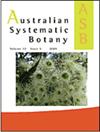Middle to Late Paleocene Leguminosae fruits and leaves from Colombia
IF 1.6
3区 生物学
Q4 EVOLUTIONARY BIOLOGY
引用次数: 22
Abstract
Leguminosae are one of the most diverse flowering-plant groups today, but the evolutionary history of the family remains obscure because of the scarce early fossil record, particularly from lowland tropics. Here, we report ∼500 compression or impression specimens with distinctive legume features collected from the Cerrejón and Bogotá Formations, Middle to Late Paleocene of Colombia. The specimens were segregated into eight fruit and six leaf morphotypes. Two bipinnate leaf morphotypes are confidently placed in the Caesalpinioideae and are the earliest record of this subfamily. Two of the fruit morphotypes are placed in the Detarioideae and Dialioideae. All other fruit and leaf morphotypes show similarities with more than one subfamily or their affinities remain uncertain. The abundant fossil fruits and leaves described here show that Leguminosae was the most important component of the earliest rainforests in northern South America c. 60–58 million years ago.古新世中晚期产于哥伦比亚的豆科植物的果实和叶子
豆科植物是当今最多样化的开花植物群之一,但由于缺乏早期化石记录,特别是来自热带低地的化石记录,该家族的进化史仍然模糊不清。在这里,我们报告了从哥伦比亚中至晚古新世Cerrejón和bogot组收集的具有独特豆科植物特征的约500个压缩或压印标本。这些标本被分离成8种果型和6种叶型。两种双羽状叶的形态被确定地放置在Caesalpinioideae中,是该亚科的最早记录。其中两种果实形态被划分为异花亚科和双花亚科。所有其他的果实和叶片形态都与一个以上的亚科相似,或者它们的亲缘关系仍然不确定。这里描述的丰富的果实和叶子化石表明,豆科植物是大约6000万至5800万年前南美洲北部最早的热带雨林的最重要组成部分。
本文章由计算机程序翻译,如有差异,请以英文原文为准。
求助全文
约1分钟内获得全文
求助全文
来源期刊

Australian Systematic Botany
生物-进化生物学
CiteScore
3.10
自引率
12.50%
发文量
12
审稿时长
>12 weeks
期刊介绍:
Australian Systematic Botany is an international journal devoted to the systematics, taxonomy, and related aspects of biogeography and evolution of all algae, fungi and plants, including fossils. Descriptive taxonomic papers should normally constitute a comprehensive treatment of a group. Short papers on individual species and nomenclatural papers must contain significant new information of broader interest to be considered. The prestigious L.A.S. Johnson Review Series is published. Other review articles will also be considered. All papers are peer reviewed.
Australian Systematic Botany is published with the endorsement of the Commonwealth Scientific and Industrial Research Organisation (CSIRO) and the Australian Academy of Science.
 求助内容:
求助内容: 应助结果提醒方式:
应助结果提醒方式:


